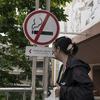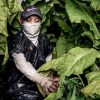Tobacco
Author and Page information
- This page: https://www.globalissues.org/article/533/tobacco.
- To print all information (e.g. expanded side notes, shows alternative links), use the print version:
Tobacco and smoking have a number of negative effects:
- Tobacco smoking kills
- Tobacco exacerbates poverty
- Tobacco contributes to world hunger by diverting prime land away from food production
- Tobacco production damages the environment
- Tobacco reduces economic productivity
- While the Tobacco industry may employ people, this can be considered an example of
wasted labor
, capital and resources.
The World Health Organization has noted that policy measures such as complete bans on tobacco advertising, promotion and its sponsorship do decrease tobacco use. However, the tobacco industry uses its enormous resources to derail or weaken laws and agreements in various countries and regions.
These issues are introduced below.
On this page:
- Tobacco Smoking kills
- Tobacco Exacerbates Poverty
- Tobacco contributes to world hunger, diverting prime land from food production
- Tobacco production damages the environment
- Tobacco Reduces Economic Productivity
- The Framework Convention on Tobacco Control
- Tobacco Industry Hitting Back
- Wasted wealth, resources and labor
- Electronic cigarettes
- Free choice?
- More information
Tobacco Smoking kills
The world’s premier health organization, the World Health Organization (WHO) is quite blunt about the impacts of tobacco and smoking:
- Tobacco smoking is the second major cause of death in the world.
- Tobacco kills nearly 6 million people each year (1 every 6 seconds)
- It is currently responsible for the death of 1 in 10 adults
- It is the leading preventable causes of all deaths
- It kills up to half of its users.
- If current smoking patterns continue, it will cause some 8 million deaths each year by 2030
- Tobacco caused 100 million deaths in the 20th century.
- At current trends up to one billion will die in the 21st century from tobacco.
- On average, a smoker killed in middle age loses about 20 years of life expectancy compared to someone who has never smoked
- An estimated 1.3 billion people smoke
- 84% of all smokers live in developing and transitional economy countries
- Most people start smoking before the age of 18; almost a quarter of these individuals begin using tobacco before the age of 10
- 47.5% of all men smoke compared to 10.3% of women.
- Tobacco is the fourth most common risk factor for disease worldwide.
-
Tobacco is deadly in any form or disguise:
- Cigarettes, pipes, bidies, kreteks, clove cigarettes, snus, snuff, smokeless, cigars…
- Mild, light, low tar, full flavor, fruit flavored, chocolate flavored, natural, additive-free, organic cigarettes, PREPS (Potentially Reduced-Exposure Products), harm-reduced…
- Second-hand smoke is also a very serious problem:
- Second-hand smoke causes 600,000 premature deaths per year.
- Of the over 4000 chemicals in tobacco smoke, at least 250 are known to be harmful and more than 50 are known to cause cancer.
- An estimated 200,000 workers die every year due to exposure to smoke at work; The US Environmental Protection Agency estimates that second-hand smoke is responsible for about 3000 lung cancer deaths annually among non-smokers in the country.
- About 40% of all children are regularly exposed to second-hand smoke at home.
- 31% of the deaths attributable to second-hand smoke occur in children.
- 10% of the economic costs related to tobacco use are attributable to second-hand smoke.
-
In 2000, fire caused by tobacco smoking caused
- 10% of all fire deaths
- 300,000 deaths
- US$27 billion in costs
- Tobacco companies spend tens of billions of dollars each year on tobacco advertising, promotion and sponsorship. One third of youth experimentation with tobacco is attributed to this spending
Sources:
- Tobacco Fact Sheet 339, WHO, updated July 2013
- Why is tobacco a public health priority?, WHO, December 1, 2004
- FAQ on the WHO Framework Convention on Tobacco Control and the context in which it was negotiated, WHO, September 20, 2004
- Tobacco: deadly in any form or disguise, World No Tobacco Day 2006, WHO, 2006
- 2008 World No Tobacco Day event, WHO, May 31, 2008
- 10 facts about tobacco and second-hand smoke, WHO, May 31, 2008
- The Tobacco Atlas; Costs to the Economy , WHO, last accessed July 2, 2008
Tobacco Exacerbates Poverty
It is worth citing the WHO again for a summary of how tobacco exacerbates poverty:
Tobacco and poverty are inextricably linked. Many studies have shown that in the poorest households in some low-income countries as much as 10% of total household expenditure is on tobacco [and therefore] less money to spend on basic items such as food, education and health care. In addition to its direct health effects, tobacco leads to malnutrition, increased health care costs and premature death. It also contributes to a higher illiteracy rate, since money that could have been used for education is spent on tobacco instead. Tobacco’s role in exacerbating poverty has been largely ignored by researchers in both fields.
John Madeley also notes in his book, Big Business Poor People (Zed Books, 1999), that heavy advertising of tobacco by Transnational Corporations (TNCs) can convince the poor to smoke more, and to use money they might have spent on food or health care, to buy cigarettes instead.
Tobacco contributes to world hunger, diverting prime land from food production
Smoking also contributes to world hunger as the tobacco industry diverts huge amounts of land from producing food to producing tobacco as John Madely also notes:
Dr Judith MacKay, Director of the Asian Consultancy on Tobacco Control in Hong Kong, claims that tobacco’s
minoruse of land denies 10 to 20 million people of food.Where food has to be imported because rich farmland is being diverted to tobacco production, the government will have to bear the cost of food imports,she points out.… The bottom line for governments of developing countries is that the net economic costs of tobacco are profoundly negative—the cost of treatment, disability and death exceeds the economic benefits to producers by at least US$200 billion annually
with one third of this loss being incurred by developing countries.
Tobacco production damages the environment
Madeley also describes in detail other impacts on land from tobacco use:
- The land that has been destroyed or degraded to grow tobacco has affects on nearby farms. As forests, for example, are cleared to make way for tobacco plantations, then the soil protection it provides is lost and is more likely to be washed away in heavy rains. This can lead to soil degradation and failing yields.
- A lot of wood is also needed to cure tobacco leaves.
- Tobacco uses up more water, and has more pesticides applied to it, further affecting water supplies. These water supplies are further depleted by the tobacco industry recommending the planting of quick growing, but water-thirsty eucalyptus trees.
- Child labor is often needed in tobacco farms.
For more detail, refer to Big Business Poor Peoples; The Impact of Transnational Corporations on the World’s Poor, by John Madeley, (Zed Books, 1999) ch. 4.
Tobacco smoking damages the environment
In The Tobacco Atlas; Costs to the Economy (last accessed July 2, 2008), the WHO noted the impact of fires caused by smoking (10% of all fire deaths, killing 300,000 people, costing $27 billion).
It also noted that 1987 saw the world’s worst forest fire caused by cigarettes happened in China in 1987, killing 300 people, making 5,000 homeless, and destroying 1.3 million hectares of land.
This hints at the side-effects of tobacco use; costly forest fires which often make for sensational headlines, especially in dry, hot conditions.
With increasing concern about climate change, the extra carbon dioxide released by such forest fires does not help.
There are also other less direct impacts to the environment. For example,
- The resources required to make cigarette lighters and related products, to package and sell them
- The resources required to box and package tobacco products
- The resources required to employ people working in the industry, to advertise and market the products
- etc.
(Many lighters are made from plastics and require a small amount of fuel. In the vast quanitities they are produced these small amounts of oil and related products that go into these can add up. As people are getting jittery about high oil prices, clean energy and so on, these kind of things add to those concerns, even if this is not seen as a priority concern.)
Given that tobacco use has no benefit for society, these costs further highlight wasted resources. While tobacco companies are somewhat held to account for the additional costs to people’s health, they are rarely held accountable for promoting products which have these additional consequences.
Tobacco Reduces Economic Productivity
Summarizing from the WHO again:
The economic costs of tobacco use are equally devastating. In addition to the high public health costs of treating tobacco-caused diseases, tobacco kills people at the height of their productivity, depriving families of breadwinners and nations of a healthy workforce. Tobacco users are also less productive while they are alive due to increased sickness. A 1994 report estimated that the use of tobacco resulted in an annual global net loss of US$ 200 thousand million, a third of this loss being in developing countries.
A report by the Campaign for Tobacco-Free Kids says that from a socioeconomic and environmental perspective, there is little benefit in tobacco growing , and that While a few large-scale tobacco growers have prospered, the vast majority of tobacco growers in the Global South barely eke out a living toiling for the companies.
Furthermore, the cigarette companies continue to downplay or ignore the many serious economic and environmental costs associated with tobacco cultivation, such as chronic indebtedness among tobacco farmers (usually to the companies themselves), serious environmental destruction caused by tobacco farming, and pesticide-related health problems for farmers and their families.
The Framework Convention on Tobacco Control
The world’s first global health treaty—the Framework Convention on Tobacco Control (summary), adopted May 2003—became international law in February 2005.
Amongst other things, the treaty requires countries to
- Impose restrictions on tobacco advertising, sponsorship and promotion;
- Establish new packaging and labeling of tobacco products (e.g. ban misleading descriptions such as
low tar
andlights
;) - Establish clean indoor air controls; and
- Strengthen legislation to clamp down on tobacco smuggling.
Treaty adopted despite heavy lobbying by big tobacco
This treaty was adopted despite a sustained campaign by the tobacco lobby via certain governments to dilute it—particularly the United States, Germany and Japan,
as the British Medical Journal (BMJ) reported (Tobacco Lobby Threatens to Derail Global Antismoking Treaty
, February 12, 2005, Volume 330, p. 325.)
Furthermore, pressure from the industry has not let up … the United States proposed a clear reference to global trade rules
potentially allowing companies and governments to attack the legally binding health treaty under trade laws, even though the … treaty gives governments the right to prioritize health over trade issues.
As the BMJ also noted, poor countries are now more vulnerable to the powerful tobacco industry and need support in implementing tough anti-tobacco measures.
In recent years, in wealthy countries, attempts have been made to introduce smoke-free legislation. In California for example, smoke-free laws were introduced in July 1998. As the Californian Medical Association’s president, Dr. Robert Hertza commented, California’s lung cancer rates have fallen six times faster than in US states without smoke-free laws.
(Smoke-free workplaces would hit tobacco profits
, BMJ, Vol. 330, p.325) This illustrates the potential of treaties such as this global tobacco treaty to save lives of millions.
WHO MPOWERing
countries with effective policies
The WHO has defined a policy approach to help implement the convention, summarized by the acronym, MPOWER, to
- Monitor tobacco use and prevention policies
- Protect people from tobacco smoke
- Offer help to quit tobacco use
- Warn about the dangers of tobacco
- Enforce bans on tobacco advertising, promotion and sponsorship, and
- Raise taxes on tobacco
As their report (see previous link) argues, these measures are shown to work and have a significant effect on reducing tobacco consumption, when applied.
Advertising bans work; self-regulation does not
In its 2013 report on the global tobacco epidemic , the WHO notes that while bans on tobacco advertising, promotion and sponsorship are effective at reducing smoking, partial bans and voluntary restrictions are ineffective.
An example of how self-regulation had failed was provided by a documentary about British American Tobacco pushing tobacco to children in Africa, produced by the BBC (which aired in July 2008).
It noted how BAT’s own guidelines to stop selling to children in various ways were clearly ignored by itself in places such as Mauritius, Nigeria and Malawi. From selling single sticks (which is intended to target children), to advertising and promotions of the sort readily banned in most countries, to organizing events and popular concerts heavily branded with BAT’s logos and products, all pointed to BAT encouraging young people, as young as 8 or 10, to smoke.
(A separate BBC article also summarizes this documentary in more detail.)
Another area where children are increasingly smoking is India. A survey by the WHO found that nearly 17% of students in India aged 15 and under use some form of tobacco, most of them cigarettes. While public bans on smoking had some positive effects, this rise has been a concern, and the study urged that more be done to tackle advertising.
Plain packaging was recently introduced in Australia as evidence suggests plain packaging works. The UK government, however, decided to pause its move to plain packaging as the evidence is not 100% (most evidence rarely is).
Tobacco taxes; one of the most effective measures to reduce smoking
The reason that raising taxes on tobacco has been seen as important is because it both raises revenues for governments (which helps fund tobacco control and social/health programs to address associated problems) and it helps deter people — especially the young — from taking up smoking.
As the WHO notes in its 2013 global tobacco epidemic report , higher taxes are especially effective in reducing tobacco use among lower-income groups and preventing youth from starting to smoke. An increase in the retail price of cigarettes by 10% will reduce consumption in high-income countries by about 4% and in low- and middle-income countries by up to 8%; smoking prevalence is usually decreased by about half those rates.
The prestigious New England Journal of Medicine also noted that more than 200 million lives could be saved by the end of this century if tobacco taxes were tripled around the world.
Perhaps ironically (as raising taxes on tobacco is a publicly popular policy choice), the WHO also notes that it is the least-achieved of the MPOWER measures listed earlier. (p.80) In addition, while governments collect nearly US$ 145 billion in tobacco excise tax revenues each year, less than US$ 1 billion combined is spent on tobacco control – 96% of this is spent by high-income countries. (p.84)
Progress with more countries adopting anti-tobacco measures
In a 2008 report analyzing global tobacco use and control, the WHO found that
- Only 5% of the global population is protected by comprehensive national smoke-free legislation and 40% of countries still allow smoking in hospitals and schools;
- Only 5% of the world’s population lives in countries with comprehensive national bans on tobacco advertising and promotion;
- Just 15 countries, representing 6% of the global population, mandate pictorial warnings on tobacco packaging;
- Services to treat tobacco dependence are fully available in only nine countries, covering 5% of the world’s people;
Since 2008, however, the progress on tobacco control has been quite positive, as the WHO reports:
- 2.3 billion people — roughly a third of the world’s population — is now covered by at least one life-saving measure to limit tobacco use
- The number of people covered by bans on tobacco advertising, promotion and sponsorship, has increased by almost 400 million people residing mainly in low- and middle-income countries
- 3 billion people are now covered by national anti-tobacco campaigns
But despite this progress, to achieve the globally agreed target of a 30% reduction of tobacco use by 2025, more countries have to implement comprehensive tobacco control programs.
Tobacco Industry Hitting Back
To sell a product that kills up to half of its users requires extraordinary marketing savvy, and tobacco companies are some of the most manipulative product sellers and promoters in the world.
The tobacco companies have tried various ways to minimize damage impact to their sales and reputation. They have sought to expand markets in other areas, especially the developing world as they find the industrialized nations are increasingly hostile to their industry. Attempts at regulation are fought with various public relations attempts, and corruption.
Four companies now control 75 percent of global cigarette sales, as sophisticated strategies for supply, production and sales have produced increasingly popular global brands.
The onward march of Marlboro man epitomises this globalisation, exploiting the opportunities presented by trade liberalisation, regional organisations and the communications revolution. Control efforts are undermined by the industry’s success in developing favourable relationships with many governments, the magnitude of their foreign direct investments and the scale of advertising, marketing and sponsorship campaigns. In addition, large-scale cigarette smuggling, which comprises one-third of total exports, depletes tax revenues and further jeopardises public health.
Expanding into Developing Nations Markets
In recent years, the damage caused to a person’s health by tobacco consumption has been confirmed, attracted particular scrutiny at tobacco firms because they knew this for years, but attempted to hide their research.
Some countries, such as the US have had the resources and political will to tackle the large tobacco corporations. However, combined with the resulting smaller and tougher markets in the rich countries, multinational tobacco firms have intensified their efforts in other regions of world such as Asia, to continue growing and selling cigarettes, as well as expanding advertising (to create demand, not meet). And they have been successful, too. 84% of the estimated 1.3 billion smokers live in developing and transitional economy countries as the WHO has noted.
Targeting Children, Teenagers and Women

For their 2008 World No Tobacco Day event, the WHO noted that Most people start smoking before the age of 18, and almost a quarter of these individuals begin using tobacco before the age of 10.
Almost understandably, tobacco companies are compelled to target the young and women.
Teenagers are future consumers often highly impressionable and in some societies with significant disposable income; for any company where brand and consumption of their products are important, attracting younger members of society increases the chances of longer term lock-in.

With the tobacco industry, ironically perhaps, as their products kill their customers (or as customers try to quit), they need to find newer consumers. Younger people will take a longer time to die or quit, thus increasingly the likelihood of continued sales.
Women generally smoke a lot less than men, everywhere. It can be deadly to unborn children, too. However, tobacco companies see women as an untapped market where there is more potential to increase consumption than with men.
So, unchecked and with profit being the natural motive for the tobacco companies, children and women are understandable target consumers.
Public Relations and WHO-Discrediting Campaigns
The tobacco industry has gone to extraordinary levels to discredit the World Health Organisation and others that are fighting tobacco issues, a WHO report charges.
A Committee of Experts had been set up in October 1999 to inquire into the nature and extent of undue influence which the tobacco industry had exercised over UN organisations.
This Committee produced the report that found that the tobacco industry regarded the World Health Organization as one of their leading enemies, and that the industry had a planned strategy to
They added that the tobacco industry documents show that they carried out their plan by:contain, neutralise, reorient
WHO’s tobacco control initiatives.
- Staging events to divert attention from the public health issues raised by tobacco use;
- Attempting to reduce budgets for the scientific and policy activities carried out by WHO;
- Pitting other UN agencies against WHO;
- Seeking to convince developing countries that WHO’s tobacco control program was a
First World
agenda carried out at the expense of the developing world; - Distorting the results of important scientific studies on tobacco;
- Discrediting the WHO as an institution.
More than a decade after the above concerns are raised, the WHO finds similar strategies are still being used by the tobacco industry. Examples of tobacco control interference tactics the industry employs include:
- Influencing the political and legislative process;
- Exaggerating the economic importance of the industry;
- Manipulating public opinion to improve the industry’s image;
- Fabricating support through front groups;
- Discrediting proven science;
- Intimidating governments with litigation
Corruption
PAHO, the Pan American Health Organization (a regional office for the Americas for the WHO) issued a report titled Profits over People (17 December 2002). Looking at the Latin American and Caribbean countries and information from Philip Morris and British American Tobacco, the report details how the tobacco companies:
- Were intensely competitive but collaborated in campaigns against common threats to the industry
- Hired scientists throughout the region to misrepresent the science linking secondhand smoke to serious diseases, while cloaking in secrecy any connection of these scientists with the tobacco industry;
- Designed
youth smoking prevention
campaigns and programs primarily as public relations exercises aimed at deterring meaningful regulation of tobacco marketing; - Had detailed knowledge of smuggling networks and markets and actively sought to increase their share of the illegal market by structuring marketing campaigns and distribution routes around it; and
- Enjoyed access to key government officials and succeeded in weakening or killing tobacco control legislation in a number of countries.
They also added that these tactics and strategies are not unique to the Americas region.
Tobacco Companies Accused of Attempting to Undermine Tobacco Treaty
The non-governmental organization, Corporate Accountability International, reports that the tobacco industry is interfering with health policy around the world . The report summarized as follows:
Thailand’s case stands out as an impressive example of a developing country successfully overcoming years of powerful tobacco industry interference in health policy [by putting in place effective tobacco advertising bans]. In Nigeria, Big Tobacco is using its economic muscle to try to keep treaty ratification off the table for discussion by manipulating media coverage and influencing government agencies. Guatemala’s current situation exemplifies the need for Article 5.3 of the WHO FCTC—requiring parties to the treaty to protect public health policy from industry interference—and the importance of being vigilant to interference throughout the implementation process. The case of Guatemala also illustrates a new variation of old tobacco industry tricks, where Big Tobacco tries to pull the wool over policymakers’ eyes by advocating “regulation” while drafting legislation that actually weakens or conflicts with the tobacco treaty.
In Africa’s most populous nation (thus an attractive potential market for tobacco firms), Nigeria, the report was very critical of British American Tobacco (BAT):
In Nigeria BAT’s tactics to undermine health policies include attempting to bribe journalists with cash prizes for favorable media coverage and giving expensive gifts to regulatory agencies and government officials. The combination of a misinformed public and easily influenced government is a proven recipe for weak, corporate-friendly regulations.
Media is a top target in BAT’s efforts to misinform Nigerians. The corporation hosts expensive meals for media owners and editors, sponsors journalist association meetings, syndicates articles favoring corporate interests and tobacco products, and leverages its advertising power to stop the publication of critical articles.
But there is corruption at government levels, for they target government officials too, the report added. Common BAT tactics to influence government officials include intense lobbying and expensive gifts.
In Guatemala, the report accuses Philip Morris/Altria and BAT of trying to stall or derail Guatemala’s treaty process
which goes against the tobacco Framework treaty which requires that the tobacco industry does not interfere with government policies.
For further information in this area, see also the following:
- Corporate Accountability International’s Tobacco Campaign
- Tobacco: A Political Struggle to the Death by Gustavo Capdevila, Inter Press Service (IPS), May 31, 2006
- Tobacco Treaty Gains Hard-Fought Ground by Isaac Baker, IPS, October 25, 2005
Reports such as those mentioned above show that there is a lot of political maneuvering by large tobacco companies to lower prices, to increase sales, etc. In addition, the poor and small farmers are the ones most affected by the impacts of tobacco companies. The hard cash earned from this foreign investment
is offset by the costs in social and public health and the environment. In effect, profits are privatized; costs are socialized.
Wasted wealth, resources and labor
While the tobacco industry no doubt provides jobs for many people around the world, the total negative effects of the industry and of smoking tobacco suggests that this is wasted wealth
and wasted labor.
Talented scientists and business people currently employed by this industry could potentially be working in other areas contributing to society in a more positive way, while agricultural workers could potentially be producing less damaging products, for example.
As noted earlier, wastage also occurs in the form of deaths from fires, the environmental damage caused by forest fires started by cigarettes, the resources needed to package, distribute, and employ people in the tobacco industry, the resources needed to create additional products such as cigarette lighters, promotional materials, etc.
In a way, there is also the extra cost of anti-tobacco campaigns! Arguably, without the excessive promotion by the tobacco industry, much time and resources would not have to be devoted by the World Health Organization and other campaigners on raising these issues; other concerns could then be given more attention.
While people have attempted to hold tobacco companies to account for the health burden they introduce, they are rarely held to account for these other forms of waste.
(Wasted wealth and wasted labor and wasted resources are discussed in more depth later in this site’s section on consumption and consumerism.)
Note that this does not have to be an authoritarian ban, as free choice is still a treasured value. Instead:
- True costing of tobacco (factoring in health, environment and social costs, as well as additional economic costs that might be externalized) would increase the cost of tobacco products to a higher and more realistic value.
- That could help pay for dealing with the various damages. It may potentially deter those whose
free
choice has been influenced by the numerous public relations, advertising and propaganda of the tobacco industry. (Some countries such as the UK do add taxes onto cigarettes, but largely to only cover health costs.) - Enormous PR related resources would be freed up for other needs, such as helping the tobacco industry clean up, diversifying into other areas, etc.
- Heavily-burdened health services would additionally free up, thus leading to a potentially
snow-balling
series of positive effects.
A lot of this is perhaps wishful thinking, as the tobacco industry would lose out a lot, and no industry would like that. Their size, power and thus influence, means that they will (and have) hit back in many ways to dilute effective action.
Electronic cigarettes
Electronic or e-cigarettes appear to be an answer to quitting smoking; at least to the industry. However, health officials worry that their advertising (which has all the hallmarks of tobacco advertising in the past to glamorize smoking) will appeal to young people and undermine tobacco control policy.
That is the concern raised in the British Medical Journal. It notes that not only are marketing efforts being directed at consumers, but also to policy makers, even though the potential benefits (being safer, a healthier alternative, harmless, a pathway to quitting, etc.) may be unsubstantiated or overstated.
Free choice?
It is often argued by those who prefer to smoke and not see more and more restrictions put in place that it is their free choice to smoke. Some will add that they do not smoke in front of children, etc and thus sound responsible.
Yet, on the one hand how free a choice is it to decide to smoke? Advertising, peer pressure, modern culture, stress all combine to give reasons for people to smoke.
A documentary about British American Tobacco pushing tobacco to children in Africa, produced by the BBC, tried to ask shareholders at an annual meeting what they thought: one smugly responded that he was for free choice and happy that the questioner lived in a society where he was free to ask such questions. In other words, the free
choice to smoke was equated with the notion of freedom. This was just a regurgitation of marketing from tobacco companies that promoted similar messages decades earlier. The irony that this person freely
commented this and had not possibly been influenced by such marketing, perhaps subconsciously, was not noted!
Furthermore, it may seem like a free choice to only harm oneself when deciding to smoke, but second hand smoking also kills.
And perhaps more remote than that is people half way around the world may be going hungry because land that could have been growing and sustaining local people is now diverted into environmentally damaging and wasteful tobacco production.
If one does not wish to give up smoking because it is considered free choice, how about quitting smoking so others may have a choice?
More information
Below are a list of stories from Inter Press Service as they cover issues around tobacco further:
20 Years of the WHO FCTC: It’s Time to Make Big Tobacco Pay
- Inter Press Service

MANILA, Philippines / PANAMA CITY, Panama, Feb 27 (IPS) - The world took a historic step in the fight against tobacco when the World Health Organization Framework Convention on Tobacco Control (WHO FCTC) came into force—the first legally binding global health treaty of its kind.
WHO marks 20 years of its lifesaving tobacco control treaty
- UN News

A UN treaty that addresses the global tobacco epidemic has saved millions of lives over the past two decades, the World Health Organization (WHO) said on Tuesday.
New WHO guidelines to help millions quit tobacco
- UN News

The UN World Health Organization (WHO) on Tuesday released the first-ever guidelines for those seeking to quit tobacco use, recommending a range of initiatives, treatments and digital interventions.
Youth Speak Out Against Big Tobacco
- Inter Press Service

BANGKOK, Jun 07 (IPS) - Each year, millions of children worldwide fall prey to the targeted tactics of the tobacco industry in its attempts to lure new customers. This year’s World No Tobacco Day (May 31), aptly themed “Protecting children from tobacco industry interference”, saw global youth unite to confront the pervasive influence of Big Tobacco.
Tobacco use declining despite industry interference: WHO
- UN News

The number of people using tobacco continues to decline despite industry attempts to jeopardize progress towards stamping out cigarettes and other such products, the World Health Organization (WHO) said in a report published on Tuesday.
WHO hails Mauritius, Netherlands for tobacco control measures but global risks remain
- UN News

Despite the welcome news that more than seven in 10 people on the planet – 5.6 billion - are now protected by measures to curb the dangers of tobacco smoke, 8.7 million people still die from tobacco-related diseases every year, the UN World Health Organization (WHO) said on Monday.
US Ban on Smoking Undermined by Tobacco Industry
- Inter Press Service

UNITED NATIONS, Jun 01 (IPS) - The US has some of the strictest laws against smoking in public, including a 1997 executive order which bans smoking in all government federal buildings.
But still, the tobacco industry and its allies do not rest, says Dr. Jarbas Barbosa, Director of the Washington-based Pan American Health Organization (PAHO).
Stop tobacco farming, grow food instead, says WHO
- UN News

With hunger spreading worldwide and tobacco responsible for eight million deaths each year, countries should stop subsidizing tobacco crops and help farmers grow food, the World Health Organization (WHO) said on Friday.
Malawi: Child trafficking and forced labour push thousands to work on tobacco farms
- UN News

Large numbers of children working on tobacco farms in Malawi are missing school, 13 UN-appointed independent human rights experts said on Wednesday, urging the Government and tobacco companies there to step up human rights protection across the supply chain.
Make tobacco industry accountable for environmental damage: UN health agency
- UN News

The tobacco industry damages both the environment and human health, and needs to be more accountable for the destruction it causes, declared the World Health Organization (WHO) on Tuesday.
Child Labour: No Quick End to Children Trapped in Tobacco Production
- Inter Press Service

HONG KONG / LOME, May 17 (IPS) - Despite World Day Against Child Labour launched in 2002 by the International Labour Organization (ILO), little has changed over the past two decades for the millions of children who remain trapped.
Seeds of change in Kenya as farmers lead way on tobacco-free farms
- UN News

In Kenya, a trailblazing sustainable agriculture project has helped hundreds of farmers move away from the harmful practice of growing tobacco, in favour of a healthier alternative, the UN said on Wednesday.
Tobacco use continues to fall
- UN News

The number of tobacco users continues to decrease globally, going from 1.32 billion in 2015 to 1.30 billion last year, the World Health Organization (WHO) said onTuesday.
Progress on tobacco fight, but new nicotine products pose increasing threat
- UN News

While many countries are making progress in the fight against tobacco use, a new World Health Organization (WHO) report shows some are failing to address the problem of emerging nicotine and tobacco products.
The COVID-19 pandemic motivates millions of tobacco users to quit, but they need support
- UN News

“Quitters are the real winners in the case of tobacco”, says the World Health Organization as part of a campaign to help smokers that have decided to quit during the COVID-19 pandemic, but lack the support to do so. A new chatbot and even an AI assistant are ready to aid them in their quitting journey.
Tobacco Industry Factoid on Illicit Trade Leading Governments Astray
- Inter Press Service

BANGKOK, Thailand, Jul 21 (IPS) - A factoid is unreliable information repeated so often that it becomes accepted as fact. One such factoid repeatedly echoed across the globe by the tobacco industry is that tobacco tax increases worsen cigarette smuggling.
Case Against Tobacco Giant Could Protect Children
- Inter Press Service

NEW YORK, Dec 03 (IPS) - Legal action against British American Tobacco (BAT), one of the world's largest tobacco firms, could see the company punished for profiting from child labor and force the industry to finally confront its treatment of vulnerable workers.
Governments Must Short Circuit Tobacco Industry’s Pervasive Tactics
- Inter Press Service

BANGKOK, Thailand, Oct 25 (IPS) - The tobacco industry's new rhetoric that smoking is harmful and that its so-called less risky products will reduce the global tobacco epidemic, should see the industry stop opposing or fighting government efforts to reduce tobacco use. However, this is not the case.
Swiftly Ending Tobacco Epidemic Requires Government Action, Not Empty Promises
- Inter Press Service

WASHINGTON DC, Oct 23 (IPS) - New information published in the Morbidity and Mortality Weekly Report shows that action taken by just 11 countries – most of them low- or middle-income – has resulted in 20 million fewer adult tobacco users in 2017 compared with 2008. Seventy percent of the world's tobacco users live in low- and middle-income countries.
Why Governments Must Prioritise Sustained Tobacco Control Investment in Low- & Middle-Income Nations
- Inter Press Service

OTTAWA, Sep 02 (IPS) - Trends in global consumption of cigarettes haven't improved since the World Health Organization's (WHO) Framework Convention on Tobacco Control (FCTC) came into force, according to a study published in the British Medical Journal (BMJ) earlier this summer.
U. S. Backing for Heated Tobacco Products Triggers Misrepresentation
- Inter Press Service

BANGKOK, Thailand, Jun 14 (IPS) - Wendell Balderas is Media & Communications Manager of the Southeast Asia Tobacco Control Alliance (SEATCA)
The U.S. Food and Drug Administration's (FDA) decision authorizing the sale of Philip Morris International (PMI)'s heated tobacco system, IQOS, in the United States inadvertently puts a foot in the door to increase sales of new tobacco products in the developing world.
Revealed - A Roadmap to Defeat Tobacco Tax & Keep Indonesians Addicted
- Inter Press Service

BANGKOK, Thailand, Apr 11 (IPS) - Dr. Ulysses Dorotheo is Executive Director of the Southeast Asia Tobacco Control Alliance (SEATCA)*
The image of a smoking toddler from Indonesia horrified the world but did little to motivate local policy makers to enact measures to protect children and youth from the harms of tobacco use. Indonesia has one of the world's highest smoking rates where two out of three men and about 40 percent of adolescent boys smoke.
Tobacco Industry Targets Women in Asia
- Inter Press Service

BANGKOK, Thailand, Mar 14 (IPS) - Wendell Balderas is Media & Communications Manager & Mary Assunta is Senior Policy Advisor, Southeast Asia Tobacco Control Alliance (SEATCA)*
International Women's Day on 8 March recognized and celebrated the progress women are making globally. The day also acknowledged the risks, exploitation and suffering many continue to endure.
Thailand First Asian Nation to Join Global Efforts to Control Tobacco
- Inter Press Service

BANGKOK, Thailand, Nov 20 (IPS) - Wendell C Balderas is Media and Communications Manager, Southeast Asia Tobacco Control Alliance (SEATCA)Thailand is set to become the first Asian country to introduce standardized packaging of tobacco. On 14 November 2018, the Thai National Committee on Tobacco Control approved the Ministry of Health Regulation that requires cigarettes in Thailand to be sold in packaging stripped of the fancy, colorful and unique cigarette branding.
ILO Fails to Cut Ties with Tobacco Industry – Yet Again
- Inter Press Service

YAOUNDE, Mar 20 (IPS) - Tih Ntiabang is Regional Coordinator - AFRO, Framework Convention Alliance, CameroonLast week, the International Labour Organization's (ILO) governing body postponed yet again a decision to stop accepting money from the tobacco industry for its projects to end child labour in the tobacco growing sector.
UN Agency Defers Action Cutting Ties to Tobacco Industry
- Inter Press Service

UNITED NATIONS, Nov 21 (IPS) - Back in November 2008, the 193-member General Assembly decided, by consensus, to ban smoking and tobacco sales at the UN headquarters in New York: a ruling observed by all affiliated agencies worldwide, including the Geneva-based World Health Organization (WHO) which has severed links with the tobacco industry.
Global Campaign to Smoke Out Tobacco Firms from UN Body
- Inter Press Service

UNITED NATIONS, Oct 19 (IPS) - The world's tobacco companies – which have been widely ostracized in the UN system – may be ousted from one of their last fortified strongholds in the United Nations: the International Labour Organization (ILO).
WHO Urges Govt’s to Raise Taxes on Tobacco
- Inter Press Service

UNITED NATIONS, Jul 19 (IPS) - Seven million people die each year from tobacco-related deaths, according to a new report published by the World Health Organisation today.
Tobacco Industry Misleads Developing Countries Over Regulations
- Inter Press Service

UNITED NATIONS, Jan 13 (IPS) - Low and middle-income countries have far fewer tobacco regulations than high-income countries and are paying the price - with bigger health and economic impacts.
Uruguay’s Victory over Philip Morris: a Win for Tobacco Control and Public Health
- Inter Press Service

GENEVA, Aug 22 (IPS) - In a landmark decision that has been hailed as a victory of public health measures against narrow commercial interests, an international tribunal has dismissed a claim by tobacco giant company Philip Morris that the Uruguay government violated its rights by instituting tobacco control measures.
Author and Page Information
- Created:
- Last updated:
 Global Issues
Global Issues